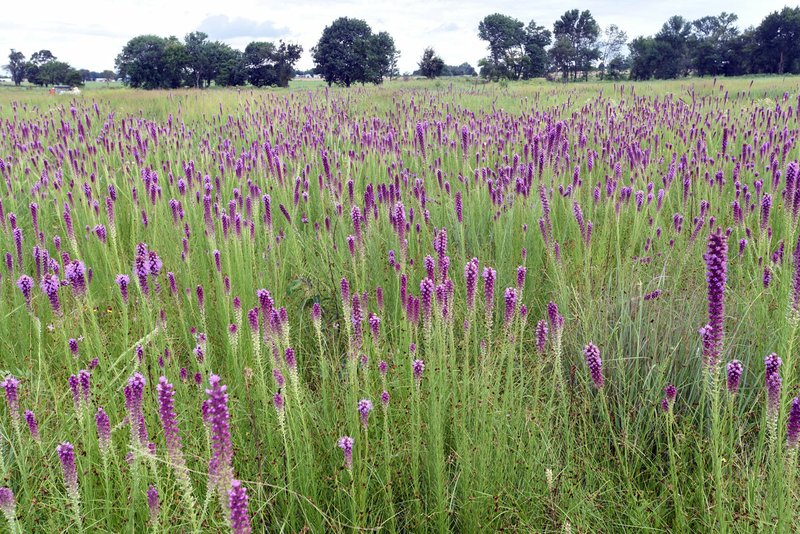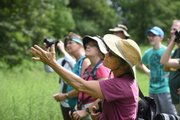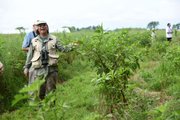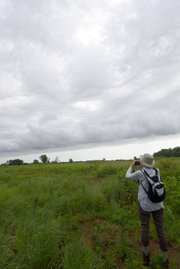Smart hikers on this summertime jaunt wore rubber boots, but not to cross creeks. Knee-high footwear helps to wade the wet grass at Chesney Prairie Natural Area near Siloam Springs.
The 82-acre public tract is one of the few tallgrass prairie remnants left in Northwest Arkansas. Summer is prime season to see wildflowers, stands of native grass and birds on the wing. Three miles of mowed trails make easy foot travel through Chesney Prairie, situated north of the Siloam Springs airport. Hikers don't have to stay on the paths, but they're nice for walking.
Visit Chesney Prairie Natural Area
Eighty-two acre Chesney Prairie Natural Area is one mile north of the Siloam Springs airport on Arkansas 59. From Siloam Springs, turn right on Bill Young Road and go 0.7 miles to Railway Alley, a farm road. Turn left and go 0.5 miles on a gravel lane to some poultry barns. The sign and entrance to Chesney Prairie Natural Area is near the barns.
— Arkansas Natural Heritage Commission
Early risers enjoy the cool of morning for a prairie trek. Grass on the trails is short, but rubber boots fend off the dew. Repellent keeps away the insects. Both were standard gear for Northwest Arkansas Audubon Society members during a visit to the prairie on July 8.
Joe Neal and Joe Woolbright led a group of about 15 through the wide open area. Neal knows birds like he has wings himself. Woolbright is caretaker of Chesney Prairie Natural Area and is a walking, talking encyclopedia of botany and prairie knowledge.
"Of the 82 total acres, 62 acres are high quality tallgrass prairie. The rest was once planted in row corps, but it's being restored," Woolbright said. Chesney is administered by the Arkansas Natural Heritage Commission.
Wildflowers wow visitors right away. Not far from the entrance, a stand of blazing star dazzles the eye with a sea of blue blossoms at the top of each flower. These perennial prairie plants bloom during summer and early fall, sporting straight, tall stems crowned with royal blue.
A beautiful passion flower now and then got hikers pointing their camera lenses toward the summertime bloom. Passion flowers also sport a bluish hue that is said to have health benefits. They are a sight for sore eyes at the very least.
Trip leader Neal pointed out a stand of poke that's a valuable native plant for birds, wildlife and sometimes people who like to make poke salad. Then he turned his attention to the sky.
"Look! There's two male goldfinches duking it out," Neal hollered to the group.
The two birds appeared to be in a dogfight high overhead, wings whirling and beaks slashing.
"They're getting real territorial. Their nesting season is just starting."
The group focused binoculars earlier in the trip on a male painted bunting and its crayon box of color. Males sport blue, green, yellow and red in their plumage.
The finale of the hike featured another battle in the sky. A scissor-tail fly catcher harassed and chased a Cooper's hawk. The fly catcher was winning.
"I've actually seen fly catchers land on the backs of flying hawks and peck at their heads," Neal said.
Joan Reynolds marveled at different wonders in the sky. A storm approached, bringing a bank of foreboding dark clouds.
"One of the most interesting things about a prairie is the sky," she mused.
Chesney Prairie Natural Area is big sky country from horizon to horizon.
Rain and sun nurture dozens of native plant varieties, which provide seed to restore other prairie areas. After the field trip, some of the Audubon folks followed Woolbright to collect seed from certain plants. Woolbright pointed out plants ripe for seed collecting. Willing workers shook the plant so seeds would drop into a paper sack. Seed is used in a statewide prairie restoration effort.
A visit to the natural area is a fine solo outing, but going with a group like the Northwest Arkansas Audubon Society is an education. Anyone is welcome to join in on the society's field trips. Audubon membership isn't required.
Field trips visit deep woods, rippled waterways and, sometimes, wide open spaces like Chesney Prairie Natural Area.
Flip Putthoff can be reached at [email protected] or on Twitter @NWAFlip
Sports on 08/08/2017




